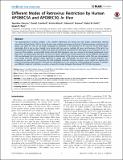| dc.contributor.author | Stavrou, Spyridon | |
| dc.contributor.author | Crawford, Daniel | |
| dc.contributor.author | Blouch, Kristin | |
| dc.contributor.author | Browne, Edward P. | |
| dc.contributor.author | Kohli, Rahul M. | |
| dc.contributor.author | Ross, Susan R. | |
| dc.date.accessioned | 2014-07-01T16:51:56Z | |
| dc.date.available | 2014-07-01T16:51:56Z | |
| dc.date.issued | 2014-05 | |
| dc.date.submitted | 2014-01 | |
| dc.identifier.issn | 1553-7374 | |
| dc.identifier.uri | http://hdl.handle.net/1721.1/88167 | |
| dc.description.abstract | The apolipoprotein B editing complex 3 (A3) cytidine deaminases are among the most highly evolutionarily selected retroviral restriction factors, both in terms of gene copy number and sequence diversity. Primate genomes encode seven A3 genes, and while A3F and 3G are widely recognized as important in the restriction of HIV, the role of the other genes, particularly A3A, is not as clear. Indeed, since human cells can express multiple A3 genes, and because of the lack of an experimentally tractable model, it is difficult to dissect the individual contribution of each gene to virus restriction in vivo. To overcome this problem, we generated human A3A and A3G transgenic mice on a mouse A3 knockout background. Using these mice, we demonstrate that both A3A and A3G restrict infection by murine retroviruses but by different mechanisms: A3G was packaged into virions and caused extensive deamination of the retrovirus genomes while A3A was not packaged and instead restricted infection when expressed in target cells. Additionally, we show that a murine leukemia virus engineered to express HIV Vif overcame the A3G-mediated restriction, thereby creating a novel model for studying the interaction between these proteins. We have thus developed an in vivo system for understanding how human A3 proteins use different modes of restriction, as well as a means for testing therapies that disrupt HIV Vif-A3G interactions. | en_US |
| dc.description.sponsorship | United States. Public Health Service (Grant R01-AI-085015) | en_US |
| dc.description.sponsorship | United States. Public Health Service (Grant T32-CA115299 ) | en_US |
| dc.description.sponsorship | United States. Public Health Service (Grant F32-AI100512) | en_US |
| dc.language.iso | en_US | |
| dc.publisher | Public Library of Science | en_US |
| dc.relation.isversionof | http://dx.doi.org/10.1371/journal.ppat.1004145 | en_US |
| dc.rights | Creative Commons Attribution | en_US |
| dc.rights.uri | http://creativecommons.org/licenses/by/4.0/ | en_US |
| dc.source | Public Library of Science | en_US |
| dc.title | Different Modes of Retrovirus Restriction by Human APOBEC3A and APOBEC3G In Vivo | en_US |
| dc.type | Article | en_US |
| dc.identifier.citation | Stavrou, Spyridon, Daniel Crawford, Kristin Blouch, Edward P. Browne, Rahul M. Kohli, and Susan R. Ross. “Different Modes of Retrovirus Restriction by Human APOBEC3A and APOBEC3G In Vivo.” Edited by Michael H. Malim. PLoS Pathog 10, no. 5 (May 22, 2014): e1004145. | en_US |
| dc.contributor.department | Koch Institute for Integrative Cancer Research at MIT | en_US |
| dc.contributor.mitauthor | Browne, Edward P. | en_US |
| dc.relation.journal | PLoS Pathogens | en_US |
| dc.eprint.version | Final published version | en_US |
| dc.type.uri | http://purl.org/eprint/type/JournalArticle | en_US |
| eprint.status | http://purl.org/eprint/status/PeerReviewed | en_US |
| dspace.orderedauthors | Stavrou, Spyridon; Crawford, Daniel; Blouch, Kristin; Browne, Edward P.; Kohli, Rahul M.; Ross, Susan R. | en_US |
| mit.license | PUBLISHER_CC | en_US |
| mit.metadata.status | Complete | |
